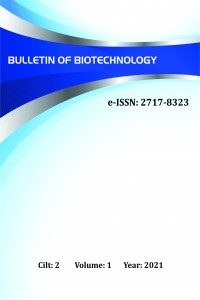Abstract
Project Number
-
References
- Akar T, Tosun İ, Özkara Z, Yeni O, Şahin E, Akar S (2009) An Attractive Agro-Industrial By-Product in Environmental Cleanup: Dye Biosorption Potential of Untreated Olive Pomace. Journal of Hazardous Materials, pp 1217-1225.
- Cheruiyot GK, Wanyonyi WC, Kiplimo JJ, Maina EN (2019) Adsorption of Toxic Crystal Violet Dye Using Coffee Husks: Equilibrium, Kinetics and Thermodynamics Study. Scientific African.
- Ho YS, McKay G (1998) Sorption of dye from aqueous solution by peat. Chem. Eng. J. 70:115-124. doi:10.1016/S1385-8947(98)00076-X
- Lagergren S (1898) Zur theorie der sogenannten adsorption geloester stoffe. Veternskapsakad. Handl. 24:1-39
- Malkoc E, Nuhoğlu Y, Dündar M (2006) Adsorption of Chromium(Vi) on Pomace-an Olive Oil Industry Waste: Batch and Column Studies. Journal of Hazardous Materials, pp 142-151.
- Selvaraju N, Rangabhashiyam S, Anu N (2013) Sequestration of Dye from Textile Industry Wastewater Using Agricultural Waste Products as Adsorbents. Journal of Environmental Chemical Engineering, pp 629-641.
- T.C. Ministry of Commerce (2019) Olive and Olive Oil Report for 2018, Artisans, Artisans and Cooperatives General Directorate, April 2019, Ankara.
- Tan IAW, Ahmad AV, Hameed BH (2009) Biosorption isotherms, kinetics, thermodynamics and desorption studies of 2,4,6-trichlorophenol on oil palm empty fruit bunch-based activated carbon. J. Hazard. Mater. 164:473–482.
- Toumi KH, Benguerba Y, Erto A, Dotto G, Khalfaoui M, Tiar C, Amrane A (2018) Molecular modeling of cationic dyes adsorption on agricultural Algerian olive cake waste. Journal of Molecular Liquids, pp 127-133.
Abstract
Crystal Violet is an inexpensive dyestuff used for silk, leather, paper dyeing and for many different purposes. In addition, culture staining is also frequently used in microbiology. It has a very dense and sticky dye. When the crystal violet dissolves in water, it significantly reduces the light transmittance and disrupts the natural environment balance. Adsorption is a method frequently used in the removal of such dyes. In this study, as an industrial waste, pirina was used as an adsorbent substance with its natural and thermally modified form. By using the pyrolysis method at 700 °C, biochar form of pirina was obtained. Natural and biochar pirina and crystal violet dye have been tried under different adsorption conditions. For this purpose, experiments were carried out at different pirina dosages, different initial dye concentrations and different contact times. The highest removal efficiencies are around 75% in natural pirina, while the biochar is around 98% in pirina. In addition, concentration studies performed against concentration were applied to the Langmuir and Freundlich isotherms and it was found that the adsorption was fit with the Freundlich model. The contact time removal studies were applied to pseudo-first order, pseudo-second order and intraparticle diffusion kinetic models, and adsorption was found to be fit with the pseudo-second order kinetic model. According to the results of the experiment, it was observed that the thermal treatment caused a great increase in the removal efficiency and it was found that it is an efficient adsorbent material that can be used to remove the crystal violet dye from the aqueous solutions.
Supporting Institution
-
Project Number
-
Thanks
-
References
- Akar T, Tosun İ, Özkara Z, Yeni O, Şahin E, Akar S (2009) An Attractive Agro-Industrial By-Product in Environmental Cleanup: Dye Biosorption Potential of Untreated Olive Pomace. Journal of Hazardous Materials, pp 1217-1225.
- Cheruiyot GK, Wanyonyi WC, Kiplimo JJ, Maina EN (2019) Adsorption of Toxic Crystal Violet Dye Using Coffee Husks: Equilibrium, Kinetics and Thermodynamics Study. Scientific African.
- Ho YS, McKay G (1998) Sorption of dye from aqueous solution by peat. Chem. Eng. J. 70:115-124. doi:10.1016/S1385-8947(98)00076-X
- Lagergren S (1898) Zur theorie der sogenannten adsorption geloester stoffe. Veternskapsakad. Handl. 24:1-39
- Malkoc E, Nuhoğlu Y, Dündar M (2006) Adsorption of Chromium(Vi) on Pomace-an Olive Oil Industry Waste: Batch and Column Studies. Journal of Hazardous Materials, pp 142-151.
- Selvaraju N, Rangabhashiyam S, Anu N (2013) Sequestration of Dye from Textile Industry Wastewater Using Agricultural Waste Products as Adsorbents. Journal of Environmental Chemical Engineering, pp 629-641.
- T.C. Ministry of Commerce (2019) Olive and Olive Oil Report for 2018, Artisans, Artisans and Cooperatives General Directorate, April 2019, Ankara.
- Tan IAW, Ahmad AV, Hameed BH (2009) Biosorption isotherms, kinetics, thermodynamics and desorption studies of 2,4,6-trichlorophenol on oil palm empty fruit bunch-based activated carbon. J. Hazard. Mater. 164:473–482.
- Toumi KH, Benguerba Y, Erto A, Dotto G, Khalfaoui M, Tiar C, Amrane A (2018) Molecular modeling of cationic dyes adsorption on agricultural Algerian olive cake waste. Journal of Molecular Liquids, pp 127-133.
Details
| Primary Language | English |
|---|---|
| Subjects | Environmental Engineering |
| Journal Section | Research Articles |
| Authors | |
| Project Number | - |
| Publication Date | June 29, 2021 |
| Acceptance Date | April 1, 2021 |
| Published in Issue | Year 2021 Volume: 2 Issue: 1 |

